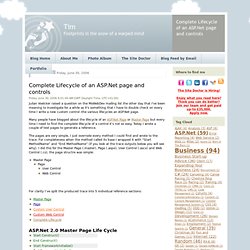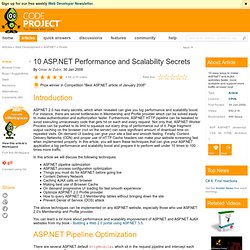

The Plain Simple Password Page Not So Simple Anymore. Development With A Dot - Saving View State in Cache. Most people who have worked with ASP.NET web forms know about view state; they may have both benefited from and cursed it, since it allows simple things to be done very easily but also as easily doing very stupid things, like filling up an HTML page with several megabytes of data which have to be submitted on each postback.

What some people won’t know is that the way the view state is maintained is extensible and based on a provider model. Besides the default way of storing view state in an hidden field, ASP.NET includes another implementation of the provider which allows state to be stored in the session, thus keeping it out (but for a small part) of the HTML. The abstract base provider class is PageStatePersister and the two included implementations are HiddenFieldPageStatePersister and SessionPageStatePersister. So, what keeps you from storing everything in the session? It seems like an easy choice… there are some drawbacks, however: OK, so let’s see the code: Mplete Lifecycle of an ASP.Net page and controls. Friday, June 30, 2006 9:01:00 AM (GMT Daylight Time, UTC+01:00) Julian Voelcker raised a question on the MsWebDev mailing list the other day that I've been meaning to investigate for a while as it's something that I have to double check on every time I write a new custom control -the various lifecycles an ASP.Net page.

Many people have blogged about the lifecycle of an ASP.Net Page or Master Page but every time I need to find the complete lifecycle of a control it’s not so easy. Today I wrote a couple of test pages to generate a reference. The pages are very simple, I just overrode every method I could find and wrote to the trace. For completeness when the method called its base I wrapped it with “Start MethodName” and “End MethodName” (if you look at the trace outputs below you will see why). .net - Hidden Features of ASP.NET. Using T4 to manage config files for complex deployment scenarios « ILearnable .Net. Dictionary<string, string> MergeConfigFiles(string inputFilesFolder, string outputFilesFolder, Dictionary<string, string[]> setup){ var ret = new Dictionary<string, string>(); var merger = new XmlConfigMerge("name", "id", "key"); Dictionary<string, string> configFiles = new Dictionary<string, string>();

Asp.net - Unable to map an HttpHandler to a "path/*" wildcard mapping. ASP.NET 2.0 Page LifeCycle. ASP.NET 2.0 Page Life Cycle is a much more granular method stack compared to ASP.NET 1.1.

The added methods provide a greater level of control to the Web developer. With that added level of control comes the responsibility to understand what these methods do and when they are called. These events can be accessed through the Page object on any ASP.NET page. The table below shows the list, and whether the method is active at all times, or only on PostBack. Mplete Lifecycle of an ASP.Net page and controls. Friday, June 30, 2006 9:01:00 AM (GMT Daylight Time, UTC+01:00) Julian Voelcker raised a question on the MsWebDev mailing list the other day that I've been meaning to investigate for a while as it's something that I have to double check on every time I write a new custom control -the various lifecycles an ASP.Net page.

Many people have blogged about the lifecycle of an ASP.Net Page or Master Page but every time I need to find the complete lifecycle of a control it’s not so easy. Today I wrote a couple of test pages to generate a reference. The pages are very simple, I just overrode every method I could find and wrote to the trace. For completeness when the method called its base I wrapped it with “Start MethodName” and “End MethodName” (if you look at the trace outputs below you will see why). Master Page Page User Control Web Control For clarity I’ve split the produced trace into 5 individual reference sections:
Der Lebenszyklus einer ASP.NET 2.0 Seite. Der Lebenszyklus einer ASP.NET 2.0 Seite. ASP.net - unbehandelte Fehler erfassen. 10 ASP.NET Performance and Scalability Secrets. Introduction ASP.NET 2.0 has many secrets, which when revealed can give you big performance and scalability boost.

For instance, there are secret bottlenecks in Membership and Profile provider which can be solved easily to make authentication and authorization faster. Furthermore, ASP.NET HTTP pipeline can be tweaked to avoid executing unnecessary code that gets hit on each and every request. Not only that, ASP.NET Worker Process can be pushed to its limit to squeeze out every drop of performance out of it. Page fragment output caching on the browser (not on the server) can save significant amount of download time on repeated visits. In this article we will discuss the following techniques: Wildcard script mapping and IIS 7 integrated pipeline : Building. The big benefit of the IIS 7 and above integrated request processing pipeline is the fact that all the nice and useful ASP.NET features can be used for any type of content on your web site; not just for ASP.NET-specific content.
ASP.NET Ajax UpdatePanel und $(document).ready();